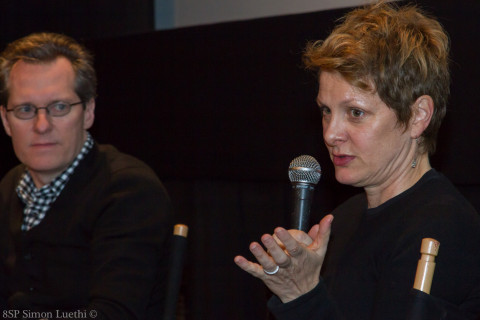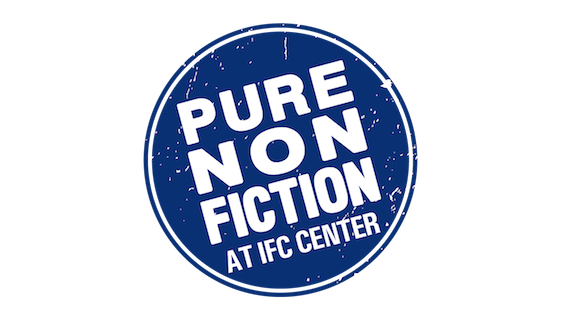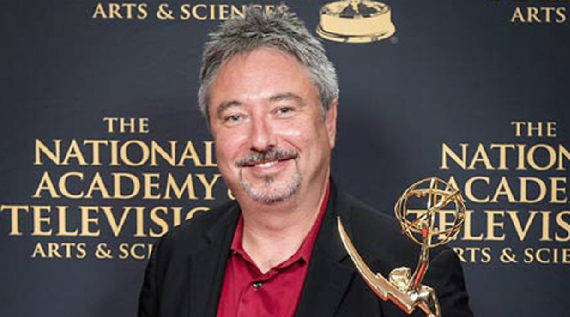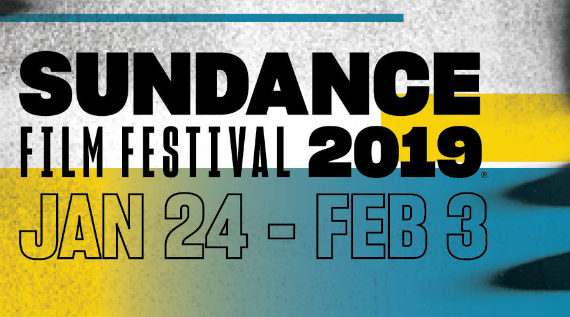
Amy Nicholson shares her passion for the ride that inspired ZIPPER.
When Amy Nicholson set out to produce Zipper: Coney Island’s Last Wild Ride, she planned to make a short film about the titular amusement park ride. After decades of providing fun and excitement to Coney Island’s visitors, the Zipper was set to retire. It was only after Nicholson began to question the reasons why the ride was leaving that she expanded the scope of the documentary to tell the story of Coney Island’s controversial development plans and the fight to preserve the neighborhood’s history and character. Zipper takes viewers inside the corridors of City Hall and along the boardwalk to explore the various perspectives on Coney Island’s evolving identity. If you’ve ever wondered how buildings and neighborhoods change so quickly, Zipper can serve as a primer.
The screening was packed with STF regulars and Zipper’s cast and crew. When the film ended, Nicholson joined STF’s Thom Powers for a discussion.
Stranger Than Fiction: Amy, what brought you to this subject in the first place?
Amy Nicholson: I grew up in the ’70s, and there was a Zipper at every fair, and also in Ocean City where I spent my summers working in a t-shirt shop. It was my favorite ride. It was just the coolest. It’s like the black-light poster of carnival rides, you know? It’s just a really cool ride. It’s analog, it scared the shit out of you, it made you throw up, it’s just cool. And they made a bunch of them in the ’70s, and then they stopped making them. When I heard the one in Coney Island was leaving, I was sad.
STF: You mentioned that they stopped making them. When you interviewed the people at Chance Rides, did you ask them why the Zipper went out of fashion?
Nicholson: I think they just…you know, time marched on, and I think they became very, very expensive, because they were made of steel. They made them up until the late ’90s, I believe, but later models were electric-driven, and that one was hydraulic, so it went a lot faster, and they had a lot more parts that weren’t solid steel. The steel ones, they last forever. I think it was just time to move on and it became very expensive to trailer-mount and insure.
STF: During the course of following the story, did you ever think it was going to go differently?
Nicholson: Yes and no. I didn’t really understand what was happening when it was happening. I was shooting my little Zipper homage, and Dick Zigun is responsible for the turning point of the film. It started to become way too big and he said, “Don’t make it bigger.” And I said, “But what if I wanted to make it bigger and understand what is behind the politics?” Dick was involved way early on. He’s the heart and soul of Coney Island. So he said, “Well, Domenic Recchia, he’s the councilman here, and it all kind of resides on him.” And I didn’t even know who Domenic Recchia was.
I, like any normal New Yorker, just walk around thinking, “Why is that a bank?” and not really understanding how it happens. I wanted to understand how it could happen. The Zipper had already left. We monkeyed with this timeline quite a bit to tell a parallel story, but the Zipper had already gone, and I just didn’t get it. I didn’t get it, and it bugged me, and I just kept digging. So a lot of the research that we did was after it had all kind of happened.
Audience: Behind the politics, what can you tell us about the overlap in relations, most especially between Joe Sitt and Domenic Recchia?
Nicholson: Joe Sitt and Domenic Recchia were friendly, and my understanding is that, when you go to the city and say, “I want to re-zone my district and do something great for my people,” it kind of has to be a business presentation. The city has to get something out of it: money, taxes, growth, and all these other lovely things that every Mayor wants to have as their legacy. So Recchia brought in Joe Sitt, because it was very difficult to get anybody to look at Coney Island and say, “Well, that could be a Riviera,” you know? It’s surrounded by housing projects. So he brought in Joe Sitt, and Joe Sitt did all those fancy drawings, and they presented it to the city, and Joe Sitt was sort of presented as the developer on the project. But that wasn’t what the city wanted, so I think they cooked up a new plan. And that’s my understanding of how all that happened.
But the overlap between the economic development corporations and city hall…they’re working for them. That’s how it is. It’s not supposed to be that way. It’s supposed to be sort of separate, but everybody’s in it for everybody. And what happens is, by the time you get to the city council, by the time you get through all those public meetings, they take the testimony of everyone yelling and screaming and go, “Thanks a lot,” they put it in a drawer, and then they kind of go do what they want. As long as Recchia agrees, all of the council-people vote the way he votes. So the next time something happens in your district, notice what your councilperson wants, because all the other council-people will want that, too, because the next time, your councilperson will return the favor. So it’s complicated. It’s a lot of politics.
STF: Have any of those political players seen the film?
Nicholson: Yes. And I’m sort of shocked that Joe Sitt hasn’t written me back, because I didn’t set out to make him the villain. I don’t like his taste in development, but I think he just took advantage of a good situation. He bet really well. I’ve had subsequent conversations with people from the city, notably Bob Lieber, who I love because he’s so straightforward. I think he’s still mad at Joe Sitt. I said, “He took a bet, he took a bet,” and Bob said, “So many guys lose their shirts on those kinds of bets, and he made out like a bandit.” So I think there’s still some resentment there.
Audience: How did you get Joe Sitt to open up like that?
Nicholson: When I go to interview someone, I just say, “Tell us whatever you want to tell us, and don’t tell us what you don’t want to tell us.” I’ll push a little bit, but not too hard. It’s not my thing. I just always feel like people reveal themselves. Somehow, people reveal themselves. When we all left there that day, we went, “He’s kind of charming,” you know? But I also think that’s very revealing. He said the word “folks,” like, 30 times in an hour. If people don’t want to talk, they don’t have to talk; if I ask a question that they’re uncomfortable with, they let me know, and then I don’t go back. I think that people will reveal who they are through the way that they talk.
Audience: I saw the documentary My Brooklyn last week, which is another film about re-zoning in Brooklyn and Joe Sitt. Is Joe Sitt just all over Brooklyn? I had no idea this was happening, but through your film and My Brooklyn, I’m now really learning about the sad politics of finance and residential markets. What has your experience taught you about the future of this city and how zoning is an issue?
Nicholson: Well, Joe Sitt is a zillionaire. I get alerts for things that he’s doing, and he’s taking over Mexico now, so it’s not just New York City. He’s a developer, and he’s successful. He’s very successful. But don’t feel bad, because I didn’t know about any of this, either. I had no idea what happens with the land use. Who would ever follow it? First of all, it takes forever. The public process takes a year for anything to happen.
And luckily, there have been other filmmakers addressing this. Kelly Anderson’s film [My Brooklyn] is brilliant. Battle for Brooklyn is brilliant. Su Friedrich’s film is great. There’s a bunch of them, and everybody followed the process for a really long time and managed to condense it down to an hour, hour and a half, which is great, because then you can come and see it, and you can see how it happens. But it happens over such a long period of time, and the public meetings are at, like, 2:00 in the afternoon. Who’s going? Everybody works. Everybody has a job. And there are so many politics involved that, even if you did go, I’m not sure it would help.
The difference between the Bloomberg administration and previous administrations is that developers used to come to the city and say, “I want to buy the West Side Rail Yards and put a stadium up there,” and then the city would respond. But in this administration…I personally think it started with the Olympics, where they said, “Well, if we want to stimulate growth in a crashing economy, let’s have an Olympics, and then we’ll have to build stuff!” And I think when that didn’t happen, they said, “Well, let’s just do it anyway.” Who’s to stop it? Who’s to say no? Just sit down and make a plan, and take it to the public, and re-zone, and give it to the developers. That’s my dummies version. I’m a layperson; I don’t know any more than the next guy, but that’s kind of what has happened.
Audience: What are the Zipper employees in your film up to now?
Nicholson: All of these guys just worked up until Christmastime, January 1, taking apart McCullough’s Kiddie Park, which is the one where the Bees were. So the Bees will no longer be there next year. They all still work in the business, doing construction and electric work. They do a lot of things.
Audience: How many hours did you shoot, and how long did it take to edit?
Nicholson: It took 600 years to edit. (laughter) We shot 165 rolls of 16mm film, but then there was a lot of ancillary footage. So we cut most of the film in the editor’s basement studio. We’re idiots that we did not take a picture of it. At one point, we were calling it the set of Se7en, because we had every single newspaper feature that had ever been written during the three-year period taped to the wall, 1,050 three-by-five cards, and a frame of every scene we shot in the film, and then lists of all the ancillary stuff we got from the news. It was crazy. And then, you know, you throw 90% of it away.
STF: Can you talk about your choice to shoot it in 16mm?
Nicholson: Yes. Well, it started as a short. (laughter) That was why. We were going to shoot a short homage to the Zipper. And at the time, you know, the Zipper is analog, it’s Coney Island, it’s old school, and it’s tactile. Somebody came to us and had won one of those prizes where you get a bunch of film, and she didn’t want it so I bought it from her. So I had all this film, and we shot that film. And then we ran out and kept shooting and buying more. But once we got to the point when we decided it was going to be bigger, we were really into interviews. And guys at City Hall, they give you 45 minutes – that’s all you’re getting. So you know you have to take five rolls of film with you. That’s all you’re going to get. So it was pretty reasonable, once we got to that point.
Audience: The exterior shots of Coney Island really set the atmosphere. Were those story-boarded, or were they improvised?
Nicholson: Well, Jerry [the DP] shot all of those, and they were improvised, but we had a little meeting ahead of time and decided that we wanted the beginning to look like Dog Day Afternoon, only in Coney Island. (laughter) The beginning of that movie sets the tone so well, so we ripped it off. (laughter) It just has rides in it instead of tollbooths.





